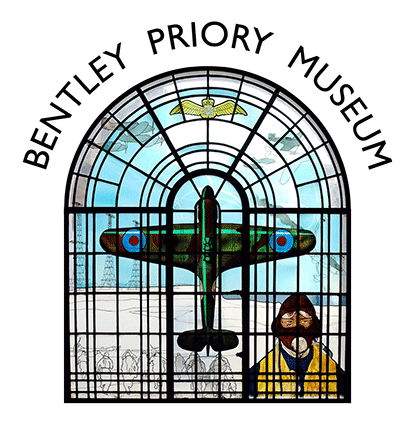Dimensions: 108cm x 193cm
Materials: Acrylic on Canvas
To listen to the audio description of this object either click the object audio MP3 file below which will play it in your default audio player, or press the play button which you will find after the object audio MP3 file and this will play it from within the web page. The play button can also be used to pause the audio. This button is followed by the elapsed and remaining time, and a further button to mute the audio.
Bentley Priory Painting Audio MP3 File
This large acrylic painting of Bentley Priory is approximately one meter high by two meters wide. It shows the Mansion House of Bentley Priory from the rear; the lush, green parkland in the foreground and the pale yellow house behind. The architecture is Georgian; there are classical columns supporting a stone balustrade balcony. The grand Mansion House has three storeys and a clock tower on the left hand side. The clock tower is positioned in the centre of the painting, with a large cedar tree to the far left.
Little is known about the Priory from which this house gets its name, but it is believed to have been situated in a different position to the existing house. In 1542 the land including the Priory was returned to King Henry VIII and subsequently the site passed through various hands, until it was sold in 1766 to James Duberly. Duberly demolished the Priory and built a larger house on the hill, which forms part of the house we know today.
In 1788, the 9th Earl of Abercorn, John James Hamilton, bought Bentley Priory. The following year he became the 1st Marquess of Abercorn and continued to make improvements to the house. He employed the eminent architect, Sir John Soane, to extend and refurbish the house which later became a prominent social scene for the elite of the time.
In 1818 the house and title passed to his grandson, James Hamilton, 2nd Marquess of Abercorn. The 2nd Marquess left Bentley Priory and took his family to live in Ireland. He leased the property out, and in 1846 it was rented by the Dowager Queen Adelaide, widow of King William IV.
After Queen Adelaide’s death, the house was rarely used and was sold in 1863 to the engineer Sir John Kelk. Kelk was a keen horticulturalist and made numerous additions to the main house and gardens, including the clock tower and pretty Italian Gardens.
In 1882 Bentley Priory was sold again to hotelier Frederick Gordon. He opened a luxurious hotel and arranged for an extension of the train line from Harrow to Stanmore to attract the London clientele seeking a rural retreat. However, the hotel did not prove to be successful and it eventually closed. Following this it was used as the Gordon family’s home.
After Gordon’s death, the house was sold to a syndicate, of which the Gordon family still retained a stake, and was opened in 1908 as a school for young ladies. The school had a music focus with soundproof rooms for pianos. The girls also had golf lessons and performed plays for the local community.
The school closed in 1924 and the site was split into lots for sale. The main house and some of the surrounding land was purchased by the Air Ministry and the RAF’s time at Bentley Priory began.
 What’s On
What’s On Opening Hours & Admission
Opening Hours & Admission

